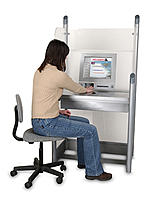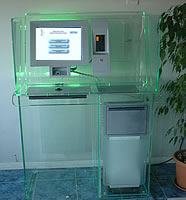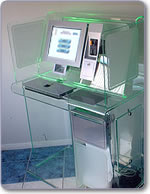
|
For all Health Information Portal enquiries, please contact Egton.
|
Health Information Portal
Health Information Portal – bringing information to patients the easy way.
A Health Information Portal is the fast, easy way for patients to view their medical records, find health information and help your practice earn nGMS contract points.
The kiosk is a groundbreaking patient communication tool that offers four optional modules:
- Medical record viewer
- Online Health Information and Education
- Patient Questionnaires
- Blood pressure and heart rate measurement
The Health Information Portal can be used in many environments from GP surgeries and hospitals, through to walk in clinics and council services.
The Health Information Portal can be controlled using an easy-to-use touch screen interface or a track ball mouse, and the simple instructions direct patients through a summary of their medical record and enable them to access health information – while they wait for their appointment.
Practices can also choose to offer printable information for patients to takeaway (printer option required).
This includes Patient Information Leaflets (PILS), medication information and copies
of referral correspondence.
 Secure access and patient confidentiality
Secure access and patient confidentiality
The specially designed Health Information Portal kiosk provides a safe and
controlled environment for patients to view their medical records within the surgery.
Unique fingerprint authentication offers a secure,
reliable and accurate method for patient identification – with no swipe card or password to be remembered.
Polarised screen filters ensure privacy for patients
and maintain record confidentiality. Information can
only be seen by the patient directly in front of the
screen, and cannot be overlooked by those nearby.
Patient interaction
Using the kiosk, patients can:
- Quickly view their electronic medical record – without involvement from practice staff
- Find clear explanations of their condition and treatment
- Learn about conditions and medication via information linked to diagnoses within the record
- Obtain general health improvement information for themselves, friends and family
- Print off information for further reference at home
- Take part in practice surveys – contributing towards nGMS points for your practice
- Through enhanced knowledge, become involved in decisions about their care
 Research has shown that patients feel having access
to their medical records improves trust, understanding
of their illness and the doctor-patient relationship. In
summary, using a Health Information Portal at your practice can improve
patient confidence, encourage self-management and
enhance the patient experience.
Viewing the contents of the medical record enables
a patient to ensure its accuracy and provides the
opportunity to give informed consent for disclosure.
Research has shown that patients feel having access
to their medical records improves trust, understanding
of their illness and the doctor-patient relationship. In
summary, using a Health Information Portal at your practice can improve
patient confidence, encourage self-management and
enhance the patient experience.
Viewing the contents of the medical record enables
a patient to ensure its accuracy and provides the
opportunity to give informed consent for disclosure.
Available options:
Medical record viewer
Designed for ease of use, patients can easily navigate
around their electronic medical record. Jargon-free
language and a simple viewing structure are used so
that a patient can easily find information and understand
content.
Five clear sections consist of:
- Summary medical record – showing diagnoses, investigations, and procedures
- Consultations – dates, reason for visit, history, examination, outcome, investigations
- Test results – for each test the previous results can be seen in tabular and graph form
- Medications and vaccinations – all current
prescriptions are displayed with last date of
issue - Attachments – including hospital referrals, general correspondence and scanned letters.
QOF questionnaires
Previously, the management of General Practice
Assessment Questionnaires (GPAQ) has been a
complicated, manual process. Through automation,
HIP has revolutionised this process, meaning you can easily maximise your nGMS points for patient surveys
under the QOF framework, and recover the cost of your HIP investment.
Using HIP, it’s easy for patients to complete the questionnaire, and results are instantly entered into a data file on the kiosk – without any re-keying of information or results. Practice staff can view a summary report at any point to manage and view the number of patients that have completed the questionnaire. Once the minimum number of responses is collected, the practice can choose to export the results to Microsoft Excel or Access. Additional software, which is freely available, can be used to illustrate the results in various graph formats and carry out the required analysis.
 GP and nurse questionnaires are available in a variety
of languages, and can be recorded anonymously via
patient fingerprint or using a numbering system.
With up to 70 nGMS points available for completing
a GPAQ questionnaire, analysing results and involving
patient discussion – HIP can help your practice earn
up to £2,550 per GP.
GP and nurse questionnaires are available in a variety
of languages, and can be recorded anonymously via
patient fingerprint or using a numbering system.
With up to 70 nGMS points available for completing
a GPAQ questionnaire, analysing results and involving
patient discussion – HIP can help your practice earn
up to £2,550 per GP.
Online health information
HIP’s online health information option offers access
to more than 3,000 Patient Information Leaflets (PILS)
including information on medications, support groups,
tests and investigations, diseases, diagrams and body
systems.
HIP also links to health improvement resources on the web – such as self diagnosis engines, promotional health literature including advice on diet, smoking cessation and exercise, and links to useful external web sites such as NHS Direct, patient.co.uk, the PCT web site etc – all defined by the practice.
 Patient monitoring equipment
Patient monitoring equipment
Blood pressure and heart rate can be taken whilst the patient is at the kiosk and filled immediately into the medical record. This helps the practice meet various QOF targets

 0845 123 2294
0845 123 2294

